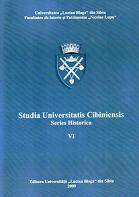Despre o marcă de olar descoperită la Vlădeni-Popina Blagodeasca (jud. Ialomiţa)
On a Potter’s Mark discovered in Vlădeni – Popina Blagodeasca (Ialomiţa County)
Author(s): Cristina Paraschiv-Talmaţchi, Emilia CorbuSubject(s): Archaeology
Published by: Editura Universitatii LUCIAN BLAGA din Sibiu
Keywords: Romania; Vlădeni-Popina Blagodeasa; Early Medieval Pottery; Potter’s Mark.
Summary/Abstract: Starting with the year 2000, the archaeological site from Vlădeni (Ialomiţa County) – the Popina Blagodeasca point, is under systematic investigation. We are dealing with an eroded portion on whose surface, of around 20 hectares, the vestiges of three settlements have appeared: Neolithic, Geto – Dacian and early medieval. In 2005, people have discovered the lower side of a vessel, baked in a non-oxidizing manner, one that displays, on the exterior part of its bottom, a potter’s mark, set in relief, which portrays a rider (pl. I/2; pl. II/2). It has appeared in the access hole of the household kiln nr. 6 (pl. I/1). The mark on which we dwell in this study represents, for all we know, at this stage of the research, a unique piece. The manufacturers probably wished the mark to be composed of two sections: a central medallion and the area between this and the vessel’s bottom. The second section displays 8 arms grouped in three bunches (two composed of three arms each, and one composed of two arms), bunches positioned at relatively equal distances (5; 5 and 6 cm. respectively). In the central medallion, delimited by a well outlined circle, with a diameter of 4, 4 – 4,5 cm., a horse and a rider were depicted. The horse, whose head reaches the edge of the medallion, joining it, is oriented towards the left and has one of the front legs in an erected stance. So as to continue the description of the image from the medallion, we must mention this: the soil from the site at Vlădeni favours the sedimentation and depositing of limestone on the ceramic vessels. In this case, it covered the upper side of the rider, allowing people to glimpse (according to the site’s foreman) a head, slightly stretched, shown from the front, with a slightly protruding beard, with the hair (or aura) rounded about the shoulders and slightly pointed at its upper side. This image has intensely deteriorated following the rinsing, with an inadequate substance, in the restoration laboratory, a fact that is obvious for the entire bottom of the vessel. Now the rider has no more details, only an arm, weakly outlined, directed at the horse’s neck. Between him and the edge of the medallion, there are a few areas left that are slightly set in relief, that seem to indicate the presence of some of the now indescribable elements. The side at the horse’s back is also blurry, the side where only one leg can be made out for certain. The vessel with a potter’s mark from Vlădeni-Popina Blagodeasca is dated to the second half of the 9th century – the first half of the 10th century, and now it is up to future research to confirm or not the period that we have propounded. To support this dating, we bring materials corresponding to the archaeological site to which the vessel belongs, the results of the archaeo-magnetic analysis performed on the sample from the firing bed of the hearth from kiln nr. 6, as well as the vessel’s characteristics.
Journal: Studia Universitatis Cibiniensis. Series Historica
- Issue Year: 2009
- Issue No: VI
- Page Range: 55-64
- Page Count: 10
- Language: Romanian
- Content File-PDF

